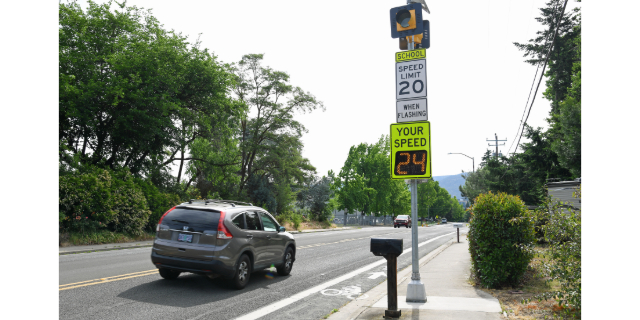Rogue Valley K-12 schools, SOU order overdose-reversing naloxone kits
Published 2:00 pm Monday, December 18, 2023

- Ron Havniear, executive director of leadership, security and facilities at Medford School District, is shown in this Dec. 7, 2023, photo taken at Oakdale Middle School.
When it comes to emergency support in a rural community, Butte Falls School District Superintendent Phil Long said people tend to look for it in three places: a church, library or school.
Butte Falls, a town 45 minutes northeast of Medford, has naloxone kits in its library and some churches, but the opioid overdose-reversal drug is not currently found in its public schools.
That will soon change because the Save Lives Oregon Initiative’s Harm Reduction Clearinghouse Project — an Oregon Health Authority initiative — is expanding to allow schools serving seventh-graders and up to order them free of charge.
Colleges and universities, school-based health centers and tribal communities also qualify to order kits.
The kits contain a wall-mounted naloxone box, which includes eight doses of naloxone nasal spray — the opiate antidote also known by the brand name Narcan — along with emergency supplies and instruction posters in English and Spanish.
Eligible schools are entitled to three kits. They are expected to arrive in two to three months.
Ebony Clarke, OHA director of behavioral health, said in a press release that the opioid epidemic and overdose crisis “impacts every community in Oregon.”
“While overdose events on school property are rare, our school communities should be prepared to respond to an overdose medical emergency,” Clarke stated.
Since the online application went live Nov. 20, 594 educational institutions have applied for the kits as of Monday, according to OHA.
Jackson County schools that applied are: Logos Charter School, Prospect Charter School, Madrone Trail Public Charter School, Grace Cascade Christian Schools, Butte Falls School District, Central Point School District, Eagle Point School District, Phoenix-Talent School District and Three Rivers School District.
Southern Oregon University also applied. Rogue Community College, meanwhile, is “exploring” how it might have the kits on its campuses, according to RCC Public Information Officer Kelly Gonzales.
Long said he is appreciative that Butte Falls schools and others throughout the valley can apply to receive the kits.
“For us, the opportunity to finally get these and have them available, it’s not just about a student or a staff (member). It’s about our community, too,” Long said.
Previously, several Rogue Valley school districts partnered with the nonprofit Max’s Mission to receive naloxone kits.
“We have helped where we can,” said Julia Pinsky, executive director of Max’s Mission, a Medford-based nonprofit that provides naloxone and education about how to use it.
The nonprofit has assisted the Clearinghouse Project, according to Pinsky, who cheered the announcement of providing kits to schools.
“I think it’s a great thing,” Pinsky said. “We know that there are great people on there (Clearinghouse Project) trying to do as much as they can — but you can only do as much as you can when you have the funding to do that.”
The ability to provide naloxone kits to schools is possible after the Clearinghouse Project received one-time funding from the Oregon’s Opioid Settlement Prevention, Treatment and Recovery Board, according to an OHA news release.
Pinsky — a mother whose son died in 2013 from an opioid overdose — is hopeful any student who receives naloxone in an emergency situation is grateful for it.
“When kids are young, sometimes they will brush something off — ‘It didn’t really happen to me’ — like anybody sometimes will,” Pinsky said. “But like having a fire extinguisher … you have these things there so the right thing can be done at the right time.”
Long said three kits that his district ordered will add to the current supply of EPIPENs and automated electronic defibrillators.
“This is one of the things that state government can do that can really make a difference,” Long said. “It’s the potential to save a life, but also the assurance that we have a way to respond if we have an emergency like this in our community. I think that is an example of good government.”
Long said his district has not had any opioid or fentanyl overdoses in the eight years he has led the district.
“But I know that the regret of not having things is a very painful place to be, too,” Long said. “That’s why we’re pursuing the (Clearinghouse Project); we just want to make sure we’re covering all bases.”
Some educational institutions that already have naloxone kits, such as SOU, have chosen to order more kits as a result of the Clearinghouse Project’s announcement.
Russell Deen, SOU’s environmental health, safety, risk and custodial manager, said three kits will be added to the 39 kits the university already has on hand. The current supply covers almost every building on campus as well as being used by individual public safety officers.
The three additional kits could go to a trio of small buildings on campus that don’t yet have the kits, according to Deen: the Plunkett Center, the Central Building and an unnamed building in the 500 block of South Mountain Avenue in Ashland.
“We chose those buildings mainly for additional coverage for safety,” Deen said. “The safety of the students, as well as the employees and the public, is of utmost importance to us.”
He said the current rise in overdoses in Jackson County is another reason the kits are important.
No information on the number of opioid overdoses at SOU is available at this time, he said.
“The kits are not under lock and key, so we have had kits that have come up missing and we’ve replaced those,” Deen said. “I don’t know if they were utilized and never reported.”
Like SOU, Medford School District already has naloxone kits.
But the district chose not to order more kits in response to the recent announcement because its schools are already fully stocked, according to Ron Havniear, executive director of security, leadership and facilities for the district.
He said that it is “nice” that schools can order more through the Clearinghouse Project.
“It’s one less barrier to getting the product into the schools,” Havniear said.
He said the district is aware opioid overdoses are “on the rise” locally and having naloxone kits are one way to “get ahead of the curve” and have them in the schools if they’re needed.
“We would rather have it and not need it than need it and not have it,” Havniear said. “The tragedy of fentanyl-type drugs is that it’s indiscriminate and can impact anybody.”






